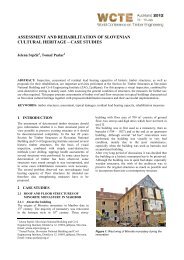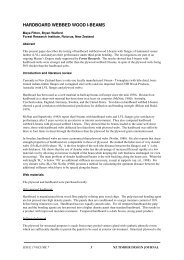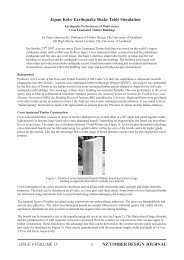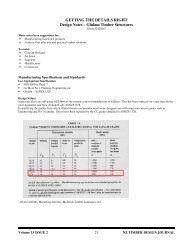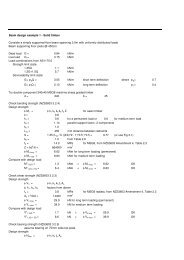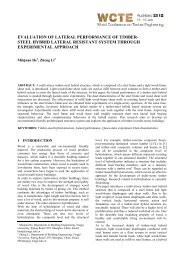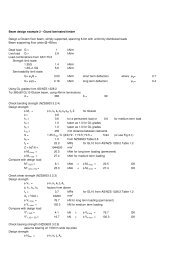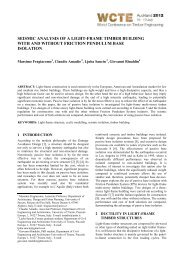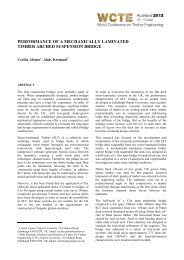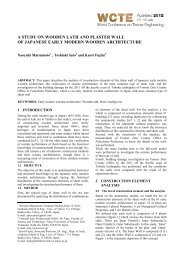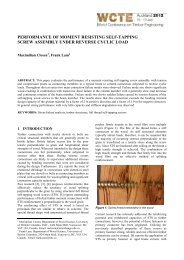WAITOMO CAVES VISITOR CENTRE Alistair Cattanach, BE (Hons ...
WAITOMO CAVES VISITOR CENTRE Alistair Cattanach, BE (Hons ...
WAITOMO CAVES VISITOR CENTRE Alistair Cattanach, BE (Hons ...
You also want an ePaper? Increase the reach of your titles
YUMPU automatically turns print PDFs into web optimized ePapers that Google loves.
2-M16X200 COACH SCREWS, SHOP<br />
DRILL SHANK Ø X LENGTH. SITE DRILL<br />
ROOT DIA. TO 220 LONG<br />
4X/ 8MM OUTER<br />
THREADED DIA. 300<br />
LONG SPAX SCREWS<br />
110 40<br />
their perimeter members. With the cushions connected<br />
in a series these forces balance, but still the perimeter<br />
of the overall roof is subject to high (3-8kN/m) pull-in<br />
forces. These are resisted by a complex series of edge<br />
catenaries and tethers as shown in the images below.<br />
3-14g BATTEN<br />
SCREWS, 150 LONG<br />
Figure 7. Typical block detail<br />
90<br />
STRUCTURAL ACTIONS<br />
In the first instance, the timber ribs act as large arches<br />
spanning the 28m across the structure. These arches<br />
are made from two layers of LVL ribs interconnected<br />
with intermittent blocks. By clamping the blocks<br />
between the two layers, Vierendeel action allows<br />
localised loads to be shared out to the greater shell<br />
structure.<br />
Because the arches are arrayed around a circle of<br />
revolution, when wind actions try to rack the structure,<br />
the diagonal nature of the grid causes it to lock up as it<br />
rolls forward, i.e. the arches at the end are skewed to<br />
the arches in the centre, and hence under racking loads<br />
the ends act as diagonal braces.<br />
Because of the unusual geometry, wind actions on the<br />
structure were derived from a wind tunnel test. The two<br />
dominant load cases were maximum uplift from the wind<br />
blowing in the end of the structure, and the forward<br />
racking of the shell from the wind blowing down the hill.<br />
As the structure weighs less than 30kg per square<br />
metre, gravity load cases did not dominate over wind.<br />
Figure 9. Top edge catenaries<br />
The structure needs to allow for any one cushion to<br />
become deflated suddenly, and repaired/replaced. With<br />
the e-plane over 0.5m above the t-plane, the resulting<br />
twisting forces on the intermediate structural members<br />
would usually be immense. To counter this, we<br />
conceived a world-first system where the cushions are<br />
held on a series of flexible poles above the timber<br />
structure. The e-plane is therefore free to move above<br />
the t-plane as unsymmetrical loads are placed upon the<br />
utilising a 20mm pad of neoprene at the fixing point.<br />
Figure 10. Major Edge support<br />
Figure 8. T-plane cables<br />
allowing the two ends of the shell to move towards each<br />
other. Similarly, as the structure eases down when the<br />
wind drops, or under gravity loads, the tips relax<br />
downwards and outwards. To control these tendencies, a<br />
net of cables were included in the t-plane: cables<br />
crossing the diamonds inhibit this scissoring action. The<br />
dominant uplift loads are evident in the greater number<br />
of transverse cables, as shown in the diagram below.<br />
The ETFE cushions resist forces by pulling inwards on<br />
Figure 11. Lower edge catenaries<br />
NEW ZEALAND TIM<strong>BE</strong>R DESIGN JOURNAL VOL 18· ISSUE 3 9



